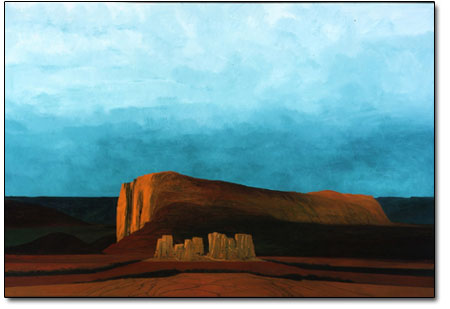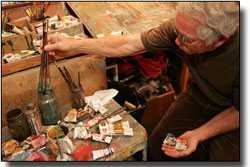|
| ||||
| A life on canvas SideStory: Stanton goes public
by Joe Foster Stanton Englehart’s work is humbling. Standing in front of one of those epic-sized canvases, one can’t help but feel the insignificance of whatever he or she was doing before that moment; those broad, unbroken horizons, limitless possibilities and fearsome skies. I feel a measure of menace in those enormous paintings, the feeling that I’m looking into a place I’m not allowed entrance; the feeling that, were I granted entrance, I would disappear into one of those canyons forever or be swept up by a great wind and blown over a limitless horizon. I think that those of us who live here instinctually understand Englehart’s skies, their power and rapture, their silky mysteries, their fickle and unfathomable personalities. I’ve found it interesting that in his paintings of the desert canyons and the sandy expanses of the Plateau, it’s the skies, and not the landscape itself, that dominate. The contours and dangers of the canyon country and the majesty of the mountains have been the focus for so many artists, but for Englehart, the allure of the air seems to be the muse. This tells us something, I think, of the artist. Thankfully, we’ve been granted further entrance into the artist’s domain with the release of the book, Stanton Englehart: A Life on Canvas. Jules Masterjohn has authored, edited, compiled and poured her heart into this project, and the end result is a truly beautiful collaborative celebration of arguably the most beloved artist in the Four Corners. With a foreword by Joel Jones, an essay by Judith Reynolds, four pieces by Masterjohn, and photography by Scott DW Smith, this book is truly local. As a consequence, those who collaborated on this project share the love that Englehart so obviously has for this place, and so the joy of celebration is evident on every page.
Despite my love for the written word, I found one of the most delightful aspects of this book to be the way in which the essays are merely meant as frames. The book is very much about the oeuvre of an artist. The essays reveal much about the life and influences of Stanton Englehart, and so help to bring each painting into focus within the context of his life. I’m sure, though, that you’ll all do as I did and simply sit and flip through the pages, taking in each This book is set up perfectly for just that sort of perusal. Many pages are very simple; no words, no descriptions, just the arrangement of an image on a white page. The vibrancy of Englehart’s work is such that the images grab tight hold of your eyeballs, not letting go until you’ve absorbed enough to move on to the next. As one flips through, it becomes clear that, despite what you may think, you’ve probably only seen a few of Englehart’s works. In fact, he’s completed more than 5,000 paintings, and while landscapes certainly dominate the collection, his other works deserve equal attention. The paintings represented in the Women Series of the late 1960s are haunting, if not terrifying, explorations, and Englehart’s explanations of these paintings are inspiring. After finishing the book, I realized that I can’t do justice to the real impact of Stanton Englehart: A Life on Canvas. No book can do justice to the overwhelming artistic presence Englehart has had in the Four Corners, and no mere book review can hope to scrape the surface, either. I urge you to go to the Anasazi Heritage Center this Sun., Dec. 9, at 1 p.m. for the book’s first public release and a new exhibit displaying a wide array of Englehart’s work. The show includes some mixed media pieces, the Women Series, and the enormous and powers-of-speech-stealing “Seasons on the Plateau.” And whether you make it to the Center or not, you have got to see this book. •
|



